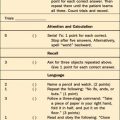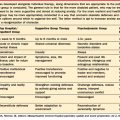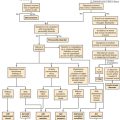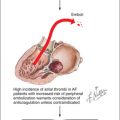CHAPTER 25 Factitious Disorders and Malingering
OVERVIEW
Factitious disorders and malingering both involve voluntary symptom production and deception of medical providers. In this light, Ford has combined these two disorders under the heading of deception syndromes.1 The deceptive nature often angers medical providers, making these patients some of the most memorable seen in our careers. The thought of a patient with an infection that requires multiple diagnostic studies and broad-spectrum antibiotics, only to be seen self-injecting feces into various body parts, seems incredulous to most. The motivation is often difficult to comprehend, but it separates the two diagnoses. In factitious disorder the motivation centers around assuming the sick role. Malingerers, on the other hand, are motivated by a clear external secondary gain (often legal or financial). The deceptive nature and the difficulty confirming the diagnosis make each of these difficult to study; thus, prevalence rates are less than reliable. The potential subjective nature of determining the motivation (which is often murky at best) further complicates matters. It seems clear, however, that the disruption caused by these patients to themselves and to the larger medical system is significant and merits further discussion in this chapter.
FACTITIOUS DISORDERS
Factitious illness is a complicated disorder that is marked by the conscious production of symptoms without clear secondary gain. Unlike malingering, where there is obvious secondary gain, those with factitious disorder are driven to feign illness without obvious direct benefit except to assume the sick role; in fact, they often put their health at considerable risk. They may fake, exaggerate, intentionally worsen, or simply create symptoms. They do not admit to self-harm, but rather hide it from their doctors; herein lies the paradox—those with factitious illness come to health care providers requesting help, but intentionally hide the self-induced cause of their illness. Table 25-1 lists the Diagnostic and Statistical Manual of Mental Disorders, Fourth Edition, Text Revision (DSM-IV-TR) criteria for factitious disorder.2 The DSM further describes three subtypes of factitious disorders (depending on predominant signs and symptoms): with predominantly physical signs and symptoms, with predominantly psychological signs and symptoms, and with combined psychological and physical signs and symptoms. Finally, factitious disorders not otherwise specified (NOS) includes the notable example of factitious disorder by proxy (or Münchausen by proxy). Each of these types will be further discussed in the following sections.
| Criterion A | Intentional production of physical or psychological signs or symptoms: |
| Fabrication of subjective complaints (e.g., acute abdominal pain) | |
| Falsification of objective signs (e.g., manipulating a thermometer) | |
| Self-inflicted conditions (e.g., production of an abscess by injecting saliva) | |
| Exaggeration or exacerbation of preexisting condition (e.g., feigning grand mal seizures by an individual with a seizure disorder) | |
| Any combination of the above | |
| Criterion B | Motivation for this behavior is to assume the sick role |
| Criterion C | External incentives (e.g., economic, legal, and drug seeking) are absent |
FACTITIOUS DISORDER WITH PHYSICAL SIGNS AND SYMPTOMS
In factitious disorder with predominantly physical signs and symptoms, the common presentation is that of a general medical condition. Examples of faked clinical problems run the gamut from fever, bleeding, hypoglycemia, and seizures to more elaborate productions, including cancers and infection with the human immunodeficiency virus (HIV).3–6 While the term Münchausen syndrome is often used interchangeably with the physical type of factitious disorder, the classic Münchausen syndrome is reserved for the most severe and chronic form of the disorder, which is marked by the following three components: recurrent hospitalizations, travel from hospital to hospital (peregrination), and pseudologia fantastica.7 Pseudologia fantastica is the production of intricate and colorful stories or fantasies associated with the patient’s presentation. It is a form of pathological lying characterized by overlapping fact and fiction, with a repetitive quality, and often with grandiosity or assumption of the victim role by the storyteller.1 In some cases, it may be difficult to determine whether these lies are actually delusions or conscious deceptions. Münchausen patients often make a career out of their illness. Serial hospitalizations make employment or sustained interpersonal relationships impossible. Moreover, patients who produce significant self-trauma or develop untoward complications from medical or surgical interventions become further incapacitated. The prognosis is generally poor in these cases, and patients may die prematurely from complications of their own self-injurious behavior or from iatrogenesis.
Clinical Features
While Münchausen syndrome is the most dramatic form of factitious illness, common factitious disorder is more frequently encountered.1 As opposed to those with Münchausen syndrome, these patients do not typically use aliases or travel from hospital to hospital, but rather frequent the same physician. They are well known in their health care system due to numerous hospitalizations. They still misrepresent symptoms and feign illness, but are not as prone to pseudologia fantastica. Although conflicting data exist with regard to whether factitious disorders are more common in males or females, some suggest that common factitious disorder is more prevalent in women. Other risk factors include being unmarried, an age in the thirties, experience in the health care profession, and having a cluster B personality disorder. Münchausen syndrome, on the other hand, may be more frequently seen in men in their forties who are single and have antisocial traits.1 The co-morbidity with personality disorders may be a result of rigid defensive structure, poor identity formation, and prominent dependency needs.8
The types of physical symptoms and diseases that have been faked are limited only by the imagination of those who feign them. Table 25-2 lists some common categories. Modern-day laboratory tests and diagnostic modalities may be particularly useful in distinguishing factitious symptoms from true medical illness. For example, in the case of suspicious infection, polymicrobial culture results that indicate an uncommon source (e.g., from urine or feces) is highly suggestive. Those who inject insulin to produce hypoglycemia will have a low C-peptide on laboratory analysis, while glyburide can be measured in the urine of those suspected of taking oral hypoglycemics. Laxative abuse to cause ongoing diarrhea is confirmed by testing for phenolphthalein in the stool.9 Finally, diagnostic studies in cases of suspected thyrotoxicosis (from surreptitious ingestion of thyroid hormone) reveal elevated serum total or free thyroid hormone levels, undetectable serum thyrotropin levels, low serum thyroglobulin concentration, normal urinary iodine excretion, suppressed thyroidal radioactive iodine uptake (RAIU), absence of goiter, and absence of circulating antithyroid antibodies.10
Table 25-2 Typical Clinical Presentations of Factitious Disorder
| Type | Clinical Findings or Symptoms |
|---|---|
| Acute abdominal type (laparotomaphilia migrans) | Abdominal pain—multiple surgeries may result in true adhesions and subsequent bowel obstruction |
| Neurological type (neurologica diabolica) | Headache, loss of consciousness, or seizure |
| Hematological type | Anemia from bloodletting or anticoagulant use |
| Endocrinological type | Hypoglycemia (from exogenous insulin) Hyperthyroidism (from exogenous thyroid hormone) Hyperglycemia (from withholding of insulin) |
| Cardiac type | Chest pain or arrhythmia |
| Dermatological type (dermatitis autogenica) | Self-inflicted wounds or chemical abrasions |
| Febrile type (hyperpyrexia figmentatica) | Manipulation of thermometer to produce fever |
| Infectious type | Wounds infected with multiple organisms (often fecal material) |
Adapted from Viguera AC, Stern TA: Factitious disorders. In Stern TA, Herman JB, editors: Massachusetts General Hospital psychiatry update and board preparation, ed 2, New York, 2004, McGraw-Hill, pp. 145-147.
FACTITIOUS DISORDER WITH PSYCHOLOGICAL SIGNS AND SYMPTOMS
While the majority of published cases of factitious disorder involve physical symptoms, some patients primarily feign psychological symptoms. Psychological complaints (like physical ones) encompass a broad spectrum of symptoms, including depression, anxiety, psychosis, bereavement, dissociation, posttraumatic stress, and even homicidal ideation.11–15 As with primarily physical symptomatology, separating the motive from that of playing the sick role versus one of clear and understood secondary gain (malingering) is difficult and often imperfect. In the case of factitious bereavement, for example, the patient may report a dramatic or recent loss of a child or other loved one with a display of emotion that invokes significant sympathy by medical treaters. When the truth is discovered, the reported deceased may either be still alive, have died long ago, or perhaps did not really play a major role in the patient’s life. Ganser’s syndrome, which is characterized by providing approximate answers to questions (as well as having amnesia, disorientation, and perceptual disturbances) may be related to factitious disorder with psychological symptoms.1 While it was originally described as a form of malingering (mostly by prisoners), Ganser-like syndromes may be seen in medical populations as well. Finally, when there are manifestations of both physical and psychological feigned symptoms, the patient is given the diagnosis of factitious disorder with combined physical and psychological symptoms according to DSM-IV-TR criteria.
Diagnostic Approach
As previously alluded to, making the diagnosis of factitious illness is often difficult. However, there are several elements of a general strategic approach that may be helpful. First, when factitious illness is suspected, it is essential to obtain information from all pertinent collateral sources. These may include previous or current treaters, family members, current and old medical records, and laboratory and diagnostic studies. Verification of the “facts” presented by the patient is key. Next, one looks for historical elements that are often suggestive of factitious disease. Some of these are outlined in Table 25-3.8 Recognition of typical presentations (including all of those outlined in Table 25-2) may provide further clues. When one is lucky enough to find medical paraphernalia or to observe the patient intentionally self-inflicting symptoms, the diagnosis is made. Of note, room and personal belonging searches without the patient’s permission are controversial and, in many cases, considered an invasion of privacy. Before embarking on such an endeavor, it is prudent to consider the potential ramifications carefully and to speak with legal counsel. There is no doubt, however, that in most cases the diagnosis relies on significant detective work based on a high level of suspicion.
Table 25-3 Historical Elements Suggestive of Factitious Disorder
| Multiple hospital admissions—“hospital shopping” or peregrination Many forms of identification or hospital numbers under various names Ease with medical jargon Current or prior employment in a medically related field Lack of verifiable history Few interpersonal relationships Early history of chronic illness Unexplained physical findings/multiple scars Failure to respond to typical treatments Co-morbid personality or substance abuse disorders |
Differential Diagnosis
True physical disorders (especially rare or unusual diseases with few objective findings) may mimic factitious disorders. It is essential to consider this possibility before prematurely diagnosing factitious illness. Somatization disorder (Briquet’s syndrome) and conversion disorder may also be mistaken for factitious disorder. The principal difference here is that the former are distinguished by symptoms not being under voluntary control, but rather as a result of unconscious conflicts. Moreover, these patients are typically not as savvy about medical diagnoses and there is no secondary gain. This is in contrast to those who are malingering and intentionally feign symptoms for obvious secondary gain (often financial, legal, or drug seeking).
Treatment Approach
No specific psychiatric treatment has been shown to be effective in the management of factitious disorders. There are, however, a few principles that generally prove to be helpful. The first is to avoid confrontation—especially when making the diagnosis. Direct confrontation or accusation often results in defensiveness, increased elusiveness, or flight from the hospital. Moreover, confrontation appears to be ineffective in most patients, with few of them actually admitting their behavior.5 Interventions that allow the patient to save face (which require significant skill to carry out) may be more helpful and effective.16 Being aware of negative countertransference is also essential if one is to avoid becoming judgmental or acting on the feelings of hostility so often evoked by these patients. Making an early diagnosis is one of the most important interventions, since an undiscovered diagnosis of factitious disorder exposes the patient to more potentially harmful interventions—avoiding iatrogenesis is a key element to treatment. Finally, since this illness is often highly treatment resistant, placing an emphasis on management over cure is a helpful way of reframing the treatment goals. Clear and open communication between the psychiatrist and medical/surgical colleagues is essential in this regard. Finally, legal intervention is sometimes prudent (and often required), especially in cases of Münchausen by proxy where children or the elderly are affected.
FACTITIOUS DISORDER BY PROXY
Factitious disorder not otherwise specified is reserved for disorders with factitious symptoms that do not meet criteria for factitious disorder. Factitious disorder by proxy (Münchausen by proxy) is perhaps the most notable of these. The DSM-IV-TR defines factitious disorder by proxy as “the intentional production or feigning of physical or psychological signs or symptoms in another person who is under the individual’s care for the purpose of indirectly assuming the sick role.”2 The perpetrator in this case is most often the biological mother of a young child, although the elderly and those under the medical care of others are also at risk. The perpetrator deceives medical personnel by altering records, falsifying medical history, contaminating laboratory samples, or directly inducing injury or illness on the victim.17 In a review of 451 cases of Münchausen by proxy, Sheridan18 found that victims are typically 4 years old or younger, with equal percentages of males and females. She further discovered that an average of 21.8 months elapsed between the onset of symptoms and diagnosis, and 6% of the victims died. Perhaps even more alarming is her finding that 61% of siblings had illnesses similar to those of the victims, and 25% of the victims’ known siblings were dead.18
Clinical Features
Much like general factitious disorder, the symptoms in factitious disorder by proxy are more commonly physical than psychological, and may run the gamut of any symptom within the scope of imagination. The most common presentations seem to be apnea, anorexia/feeding problems, diarrhea, and seizures.18,19 These may be induced in a variety of ways, from smothering the child to feeding the child laxatives or ipecac. Perpetrators often have some medical training or exposure to the illness affecting the child (e.g., a mother who has a seizure disorder herself). Other clinical indicators or “red flags” include the following: a patient who does not respond to appropriate treatments; symptoms that improve when the mother does not have access to the child; unexplained illnesses with other children in the family; a mother who becomes anxious when her child improves; or a mother who encourages invasive tests.17
Diagnostic Approach
As with all factitious illness, diagnosis may prove difficult unless the perpetrator is directly witnessed harming the victim. Table 25-4 outlines a practical approach to confirm the diagnosis when factitious disorder by proxy is suspected.1 This may involve significant detective work as in all cases of suspected factitious illness—the principal difference here is that when the victim is a child or is elderly, both legal obligations and privacy rights may differ from those of a typical adult patient. This is particularly pertinent with regard to mandated reporting (which varies state by state), as well as when video surveillance is proposed as a mechanism to uncover intentional harm. In general, any time that diagnostic or treatment strategies outside the usual standard of care are considered, it is best to consult with both professional medical and legal colleagues before undertaking them.
Table 25-4 Diagnostic Approach for Suspected Münchausen by Proxy
|
1. Obtain collateral information from other family members (spouse if applicable), medical treaters, and previous medical records. Verify all “facts” presented.
|
MALINGERING
The DSM-IV-TR describes malingering in the following manner: “The essential feature of malingering is the intentional production of false or grossly exaggerated physical or psychological symptoms, motivated by external incentives such as avoiding military duty, avoiding work, obtaining financial compensation, evading criminal prosecution, or obtaining drugs. Under some circumstances, malingering may represent adaptive behavior—for example, feigning illness while a captive of the enemy during wartime.”2 Table 25-5 outlines clinical indicators suggestive of possible malingering. Patients always have a clearly definable goal or external motivation for their behavior—this differentiates malingering from factitious disorders. While the prevalence of malingering is unknown, it is thought to be more common in men than women and is often co-morbid with antisocial personality disorder. Settings where these conditions intersect (e.g., prisons) likely see a higher incidence.
Source: DSM-IV-TR.
Diagnostic and Management Approach
The presence of clearly identified secondary gain is not absolute evidence of malingering—one must be careful not to miss the diagnosis of a true medical condition in this population. When malingering is suspected, however, objective tests are crucial. When these are normal, psychological testing may be in order. The Minnesota Multiphasic Personality Inventory—2 (MMPI-2) may pick up distortions or exaggerations in both physical and psychological symptoms.20 Direct confrontation is not advised since this often results in the patient becoming angry and fleeing from treatment. Strategies that allow the patient to save face (e.g., suggesting that the illness will improve soon) are generally more successful in that they allow the patient a way out. Avoiding iatrogenesis and remaining aware of one’s own anger toward the patient (so as not to act on it) are also keys to appropriate treatment.
1 Ford CV. Deception syndromes; factitious disorders and malingering. In: Levenson JL, editor. The American Psychiatric Publishing textbook of psychosomatic medicine. Washington, DC: American Psychiatric Publishing, 2005.
2 American Psychiatric Association. Diagnostic and statistical manual of mental disorders, fourth edition, text revision. Washington, DC: American Psychiatric Press, 2000. (DSM-IV-TR)
3 Sutherland AJ, Rodin GM. Factitious disorders in a general hospital setting: clinical features and a review of the literature. Psychosomatics. 1990;31:392-399.
4 Craven DE, Steger KA, La Chapelle R, Allen DM. Factitious HIV infection: the importance of documenting infection. Ann Intern Med. 1994;121:763-766.
5 Krahn LE, Li H, O’Connor MK. Patients who strive to be ill: factitious disorder with physical symptoms. Am J Psychiatry. 2003;160:1163-1168.
6 Fliege H, Grimm A, Eckhardt-Henn A, et al. Frequency of ICD-10 factitious disorder: survey of senior hospital consultants and physicians in private practice. Psychosomatics. 2007;48:60-64.
7 Asher R. Münchausen’s syndrome. Lancet. 1951;1:339-341.
8 Viguera AC, Stern TA. Factitious disorders. In Stern TA, Herman JB, editors: Massachusetts General Hospital psychiatry update and board preparation, ed 2, New York: McGraw-Hill, 2004.
9 Barsky AJ, Stern TA, Greenberg DB, Cassem NH. Functional somatic symptoms and somatoform disorders. In Stern TA, Fricchione GL, Cassem NH, Jellinek MS, Rosenbaum JF, editors: Massachusetts General Hospital handbook of general hospital psychiatry, ed 5, Philadelphia: Mosby, 2004.
10 Bogazzi F, Bartalena L, Scarcello G, et al. The age of patients with thyrotoxicosis factitia in Italy from 1973-1996. J Endocrinol Invest. 1999;22(2):128-133.
11 Thompson CR, Beckson M. A case of factitious homicidal ideation. J Am Acad Psychiatry Law. 2004;32(3):277-281.
12 Mitchell D, Francis JP. A case of factitious disorder presenting as alcohol dependence. Subst Abus. 2003;24(3):187-189.
13 Phillips MR, Ward NG, Ries RK. Factitious mourning: painless patienthood. Am J Psychiatry. 1983;140(4):420-425.
14 Sparr L, Pankratz LD. Factitious posttraumatic stress disorder. Am J Psychiatry. 1983;140(8):1016-1019.
15 Friedl MC, Draijer N. Dissociative disorders in Dutch psychiatric inpatients. Am J Psychiatry. 2000;157(6):1012-1013.
16 Eisendrath SJ. Factitious physical disorders: treatment without confrontation. Psychosomatics. 1989;30:383-387.
17 Sadock BJ, Sadock VA. Factitious disorders. In Kaplan and Sadock’s synopsis of psychiatry, ed 9, Philadelphia: Lipincott Williams & Wilkins; 2004:668-675.
18 Sheridan MS. The deceit continues: an updated literature review of Münchausen syndrome by proxy. Child Abuse Negl. 2003;27(4):431-451.
19 Rosenberg DA. Web of deceit: a literature review of Münchausen syndrome by proxy. Child Abuse Negl. 1987;11(4):547-563.
20 Lees-Haley PR, Fox DD. MMPI subtle-obvious scales and malingering: clinical versus simulated scores. Psychol Rep. 1990;66(3 pt 1):907-911.






